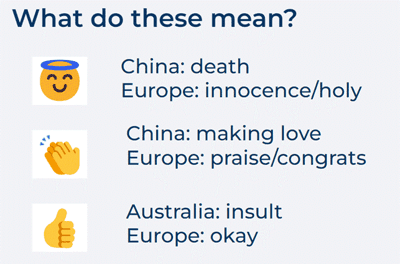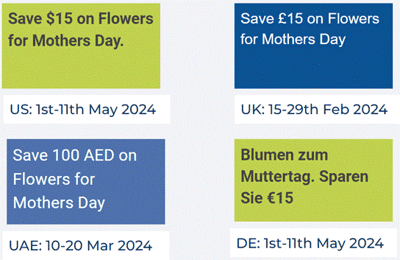The top tools for Multilingual Marketing
When considering multilingual marketing, you must ensure that you understand your target audience and what they will interact with.
This article discusses the best marketing strategies for expanding your business worldwide and into different cultures.
Understanding Cultural Nuances
Understanding cultural nuances is essential for multilingual marketing because it enables the business to resonate with target audiences and understand what they seek.We must avoid misunderstandings or offence when considering multilingual marketing, as different cultures worldwide have different communication styles.
As marketers, our main consideration is who we are trying to attract. Understanding the people seeing your ads builds authenticity and trust with our audience, making this a key tool to success.
 Let’s take emojis, for example. In our experience, these can mean different things in different countries.
Let’s take emojis, for example. In our experience, these can mean different things in different countries.
High-Quality Localisation
High-quality localisation is a hugely important factor in multilingual marketing. When translating content,
marketers must communicate with their audience correctly to demonstrate the service they are advertising in the best way possible.
Localising professional content to the highest standard means businesses are committed to understanding and engaging with different communities, resulting in quality customer connections and brand loyalty.
Ensure your content is not just translated but localised to account for the country’s cultural differences. For example, you need to consider the content and the images you use or the platforms you are reaching out on to ensure that this is adapted to the local culture you are targeting.
Poor-quality localisation can risk misinterpretation by your audience and set a low standard of professionalism within your business.

For example, consider a Flower Shop running a promotion for Mother’s Day in the US, UK, UAE, and DE. Can you spot what has changed?
The key point is not literally to translate the copy.
- Dates need checking
- Currency needs checking
- Customs need checking – is it right to run in each market?
Multilingual Content Creation
Creating content for different cultures is not as easy as it seems. You must consider the audience receiving your ads when creating content.
Cultural differences often influence how individuals consume and interact with content. Things like website layouts, design aspects, colours, and the general structure of sentencing can all be interoperated differently worldwide. By understanding these preferences for their audience, businesses can tailor
content to resonate with them and maximise lead generation.
Keyword Research
Keyword research is an essential tool in marketing, but it is even more crucial to get it right in multilingual marketing. Keyword Research allows us insights into search behaviours in certain locations, which allows us to understand the specific terms and phrases that resonate with target audiences in different languages.
By placing relevant and high-intent keywords into website content, meta tags, and other SEO elements, businesses can expand their online presence and improve their chances of being discovered by multilingual users actively seeking products or services in their preferred languages.
Understanding the local language is essential for keyword research and ensuring it is carried out correctly. In some countries, it is common for people to search in a mix of the local language or even a second language that is popular in the area.
For example, many German long-tailed keyword searches will be a mix of German and English words.
Localised Platforms
When optimising content for multilingual marketing, it is crucial to consider the local/ most popular search engines and social media platforms within the culture to ensure we rank higher and reach our target audience at their convenience.
We all know Google is one of the most popular search engines in the world, but it is not the only one, and some areas use different ones.
For our Chinese clients, we must consider that Google is not the dominant search engine; businesses and marketers must prioritise optimisation for Baidu, the country’s leading search engine.
The same goes for social media platforms; However, Facebook is the leading social channel worldwide, some parts of the world have more dominant platforms that businesses should prioritise when considering multilingual marketing as they will provide better results.
For Example, Japan uses the platform LINE, and Russia uses the platform VK.
Customer Support Services
To drive sales and provide your customers with great service, you must have a localised customer support service so that all your customers can have a seamless experience with the business.
Without multilingual customer service, your customers may feel lost and disconnected, which can make them unhappy and not want to return to your business.
On our clients’ social media channels, we ensure someone with localised knowledge can reply to any comments and stay engaged with the audience. This maintains a great customer relationship, and we often see brand loyalty.
Wrapping up
To provide a successful multilingual marketing campaign, it’s clear that investing in professional localisation services and collaborating with native-speaking translators proficient in local cultures is the best method for growth in the targeted areas. This ensures that your content builds a great connection with your multilingual audience.
To make your audience want to use your services, you have to show them they can trust and naturally engage with your business. Remember, the success of your multilingual marketing efforts relies on delivering content that feels natural and relatable across different languages and cultures.
Contact us today to get started with your multilingual marketing content!










